1、取得和设置线程名称
class MyThread implements Runnable{ // 实现Runnable接口
public void run(){ // 覆写run()方法
for(int i=0;i<3;i++){
System.out.println(Thread.currentThread().getName()
+ "运行,i = " + i) ; // 取得当前线程的名字
}
}
};
public class ThreadNameDemo{
public static void main(String args[]){
MyThread mt = new MyThread() ; // 实例化Runnable子类对象
new Thread(mt).start() ; // 系统自动设置线程名称
new Thread(mt,"线程-A").start() ; // 手工设置线程名称
new Thread(mt,"线程-B").start() ; // 手工设置线程名称
new Thread(mt).start() ; // 系统自动设置线程名称
new Thread(mt).start() ; // 系统自动设置线程名称
}
};

2、取得当前线程 currentThread()
class MyThread implements Runnable{ // 实现Runnable接口
public void run(){ // 覆写run()方法
for(int i=0;i<3;i++){
System.out.println(Thread.currentThread().getName()
+ "运行,i = " + i) ; // 取得当前线程的名字
}
}
};
public class CurrentThreadDemo{
public static void main(String args[]){
MyThread mt = new MyThread() ; // 实例化Runnable子类对象
new Thread(mt,"线程").start() ; // 启动线程
mt.run() ; // 直接调用run()方法
}
};

3、判断线程是否启动 isAlive()
class MyThread implements Runnable{ // 实现Runnable接口
public void run(){ // 覆写run()方法
for(int i=0;i<3;i++){
System.out.println(Thread.currentThread().getName()
+ "运行,i = " + i) ; // 取得当前线程的名字
}
}
};
public class ThreadAliveDemo{
public static void main(String args[]){
MyThread mt = new MyThread() ; // 实例化Runnable子类对象
Thread t = new Thread(mt,"线程"); // 实例化Thread对象
System.out.println("线程开始执行之前 --> " + t.isAlive()) ; // 判断是否启动
t.start() ; // 启动线程
System.out.println("线程开始执行之后 --> " + t.isAlive()) ; // 判断是否启动
for(int i=0;i<3;i++){
System.out.println(" main运行 --> " + i) ;
}
// 以下的输出结果不确定
System.out.println("代码执行之后 --> " + t.isAlive()) ; // 判断是否启动
}
};
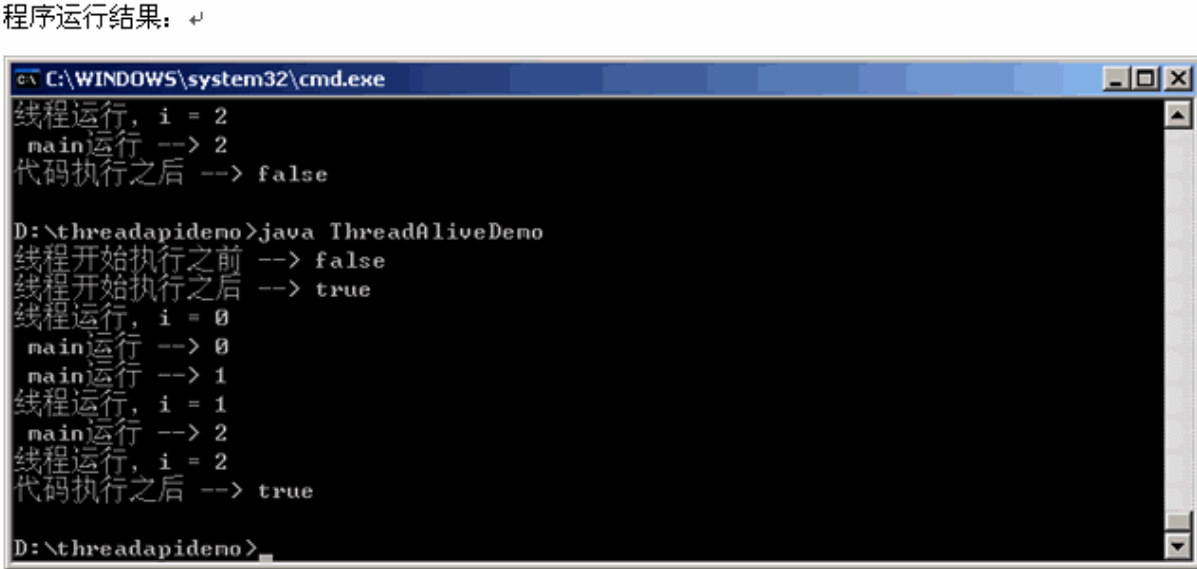
4、线程的强制执行 join()
class MyThread implements Runnable{ // 实现Runnable接口
public void run(){ // 覆写run()方法
for(int i=0;i<50;i++){
System.out.println(Thread.currentThread().getName()
+ "运行,i = " + i) ; // 取得当前线程的名字
}
}
};
public class ThreadJoinDemo{
public static void main(String args[]){
MyThread mt = new MyThread() ; // 实例化Runnable子类对象
Thread t = new Thread(mt,"线程"); // 实例化Thread对象
t.start() ; // 启动线程
for(int i=0;i<50;i++){
if(i>10){
try{
t.join() ; // 线程强制运行
}catch(InterruptedException e){}
}
System.out.println("Main线程运行 --> " + i) ;
}
}
};

5、线程的休眠 sleep()

class MyThread implements Runnable{ // 实现Runnable接口
public void run(){ // 覆写run()方法
for(int i=0;i<50;i++){
try{
Thread.sleep(500) ; // 线程休眠
}catch(InterruptedException e){}
System.out.println(Thread.currentThread().getName()
+ "运行,i = " + i) ; // 取得当前线程的名字
}
}
};
public class ThreadSleepDemo{
public static void main(String args[]){
MyThread mt = new MyThread() ; // 实例化Runnable子类对象
Thread t = new Thread(mt,"线程"); // 实例化Thread对象
t.start() ; // 启动线程
}
};
6、线程的中断 interrupt()
class MyThread implements Runnable{ // 实现Runnable接口
public void run(){ // 覆写run()方法
System.out.println("1、进入run()方法") ;
try{
Thread.sleep(10000) ; // 线程休眠10秒
System.out.println("2、已经完成了休眠") ;
}catch(InterruptedException e){
System.out.println("3、休眠被终止") ;
return ; // 返回调用处
}
System.out.println("4、run()方法正常结束") ;
}
};
public class ThreadInterruptDemo{
public static void main(String args[]){
MyThread mt = new MyThread() ; // 实例化Runnable子类对象
Thread t = new Thread(mt,"线程"); // 实例化Thread对象
t.start() ; // 启动线程
try{
Thread.sleep(2000) ; // 线程休眠2秒
}catch(InterruptedException e){
}
t.interrupt() ; // 中断线程执行
}
};

7、后台线程 setDaemon()

class MyThread implements Runnable{ // 实现Runnable接口
public void run(){ // 覆写run()方法
while(true){
System.out.println(Thread.currentThread().getName() + "在运行。") ;
}
}
};
public class ThreadDaemonDemo{
public static void main(String args[]){
MyThread mt = new MyThread() ; // 实例化Runnable子类对象
Thread t = new Thread(mt,"线程"); // 实例化Thread对象
t.setDaemon(true) ; // 此线程在后台运行
t.start() ; // 启动线程
}
};
8、线程的优先级 setPriority()
class MyThread implements Runnable{ // 实现Runnable接口
public void run(){ // 覆写run()方法
for(int i=0;i<5;i++){
try{
Thread.sleep(500) ; // 线程休眠
}catch(InterruptedException e){}
System.out.println(Thread.currentThread().getName()
+ "运行,i = " + i) ; // 取得当前线程的名字
}
}
};
public class ThreadPriorityDemo{
public static void main(String args[]){
Thread t1 = new Thread(new MyThread(),"线程A") ; // 实例化线程对象
Thread t2 = new Thread(new MyThread(),"线程B") ; // 实例化线程对象
Thread t3 = new Thread(new MyThread(),"线程C") ; // 实例化线程对象
t1.setPriority(Thread.MIN_PRIORITY) ; // 优先级最低
t2.setPriority(Thread.MAX_PRIORITY) ; // 优先级最高
t3.setPriority(Thread.NORM_PRIORITY) ; // 优先级中等
t1.start() ; // 启动线程
t2.start() ; // 启动线程
t3.start() ; // 启动线程
}
};
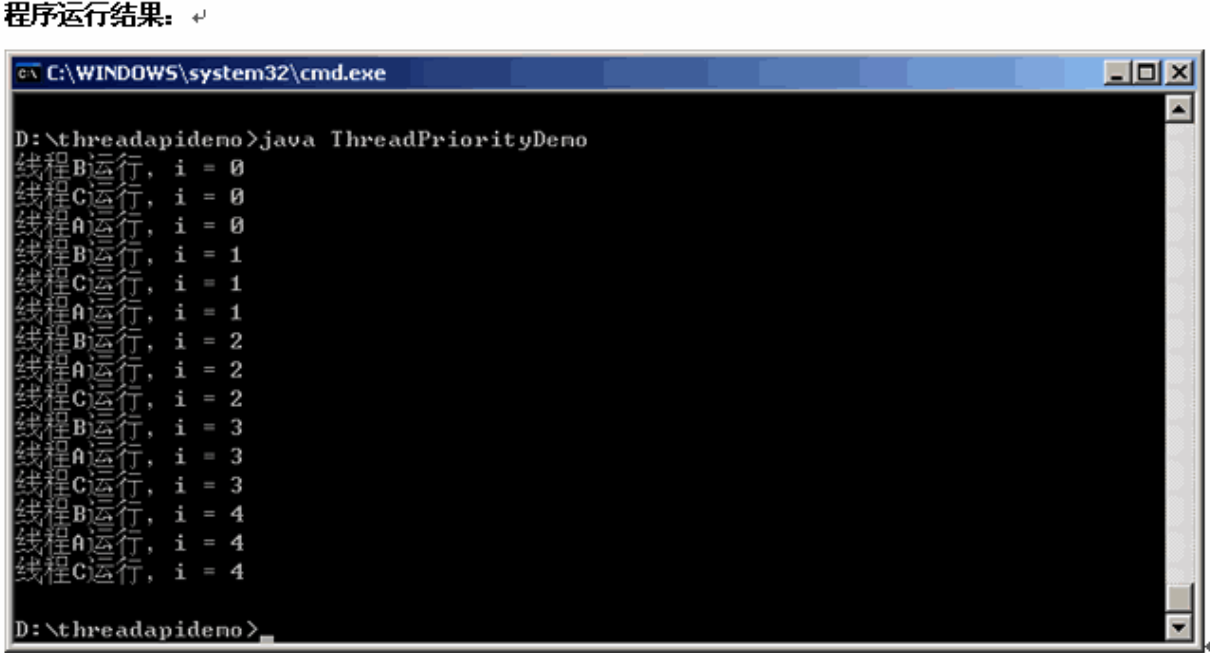
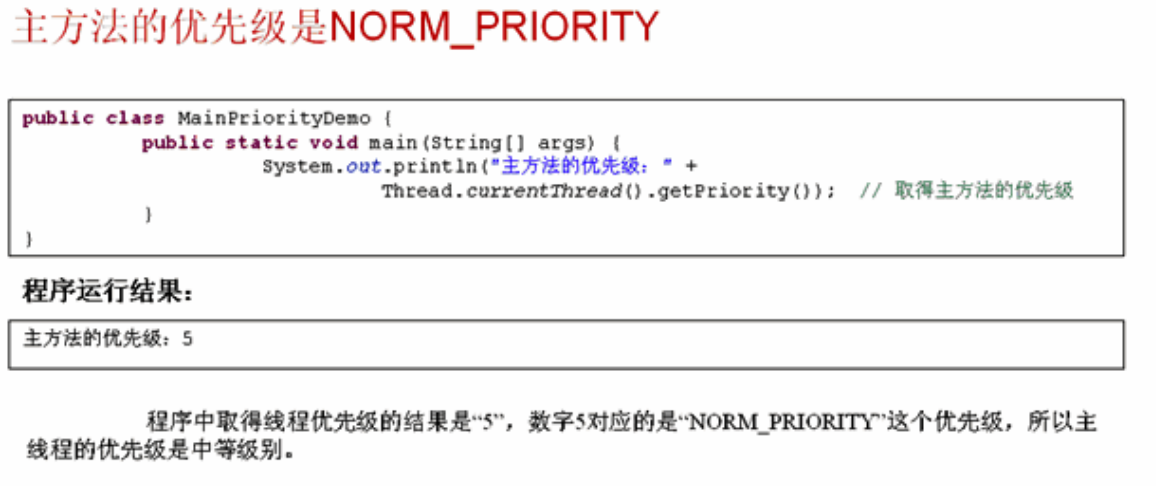
public class MainPriorityDemo{
public static void main(String args[]){
System.out.println("主方法的优先级:" +
Thread.currentThread().getPriority()) ; // 取得主方法的优先级
System.out.println("MAX_PRIORITY = " + Thread.MAX_PRIORITY) ;
System.out.println("NORM_PRIORITY = " + Thread.NORM_PRIORITY) ;
System.out.println("MIN_PRIORITY = " + Thread.MIN_PRIORITY) ;
}
};

9、线程的礼让 yield()
class MyThread implements Runnable{ // 实现Runnable接口
public void run(){ // 覆写run()方法
for(int i=0;i<5;i++){
try{
Thread.sleep(500) ;
}catch(Exception e){}
System.out.println(Thread.currentThread().getName()
+ "运行,i = " + i) ; // 取得当前线程的名字
if(i==2){
System.out.print("线程礼让:") ;
Thread.currentThread().yield() ; // 线程礼让
}
}
}
};
public class ThreadYieldDemo{
public static void main(String args[]){
MyThread my = new MyThread() ; // 实例化MyThread对象
Thread t1 = new Thread(my,"线程A") ;
Thread t2 = new Thread(my,"线程B") ;
t1.start() ;
t2.start() ;
}
};
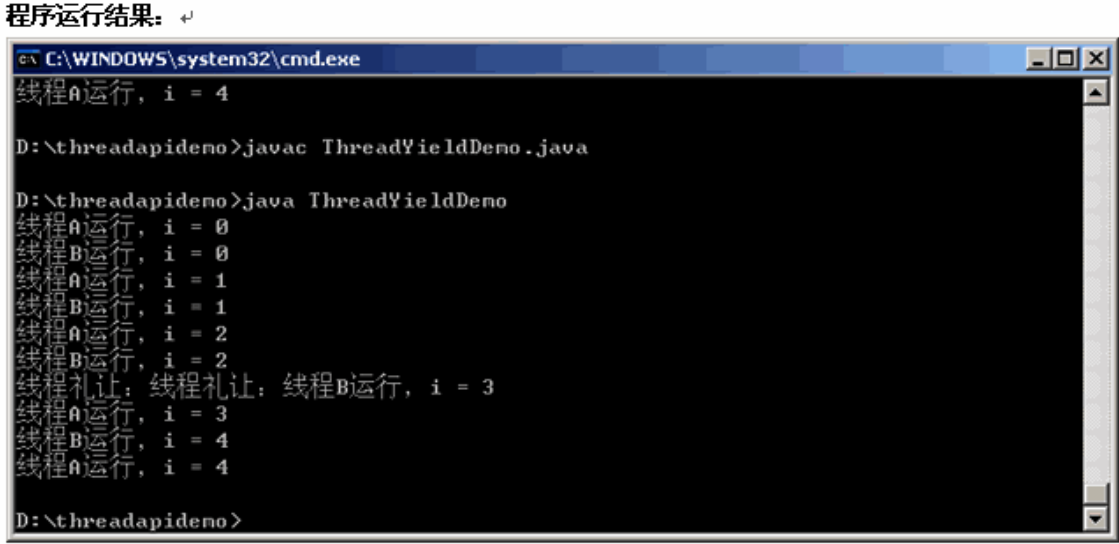











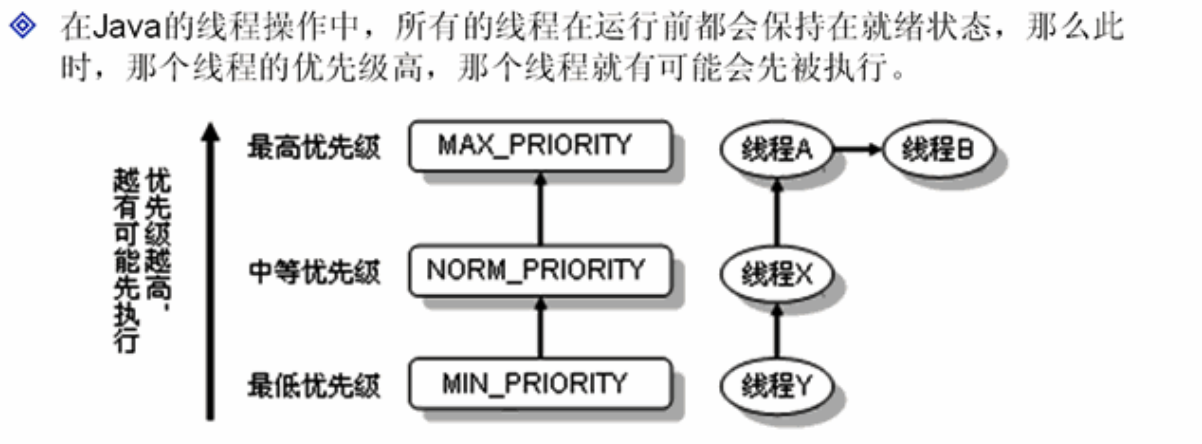





























 2644
2644

 被折叠的 条评论
为什么被折叠?
被折叠的 条评论
为什么被折叠?








